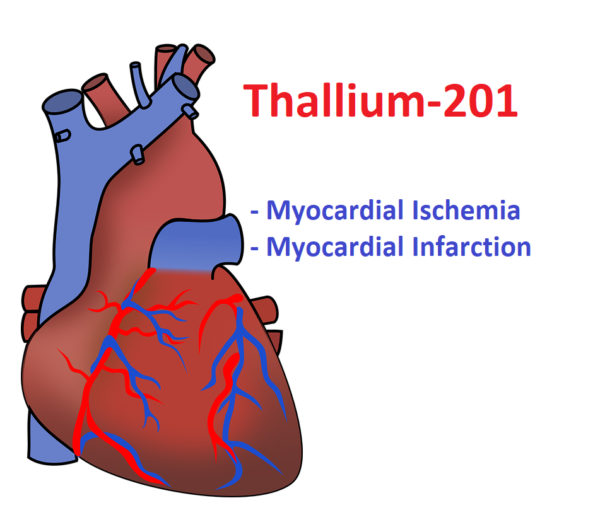Thallium-201 is used to detect myocardial perfusion. It is used in conjunction with exercise and pharmacological stress to diagnose and localize myocardial ischemia and infarction.
Thallium-201 Indications:
-
Myocardial perfusion imaging:
- It is used as an imaging modality with planar scintigraphy or single-photon emission computed tomography (SPECT) for the diagnosis and localization of coronary artery disease (to detect reversible myocardial ischemia and non-reversible myocardial infarction) when used in conjunction with exercise or pharmacologic stress.
-
Parathyroid hyperactivity imaging:
- It is used to localize parathyroid hyperactivity before and after surgery in patients who have hypercalcemia and hyperparathyroidism.
Thallium-201 Dose in Adults
Note: Use the lowest dose necessary. Individualize the dosage.
Thallium-201 Dose in the treatment of Myocardial perfusion: IV:
- Planar scintigraphy:
- 37 to 74 MBq (1 to 2 mCi)
- Single-photon emission computed tomography (SPECT):
- 74 to 111 MBq (2 to 3 mCi)
Thallium-201 Dose in the treatment of Parathyroid hyperactivity localization:
- Planar or SPECT:
- 75 to 130 MBq (2 to 3.5 mCi)
Use in Children:
Not indicated.
Pregnancy Risk Factor C
- Radiopharmaceutical products can cause harm to fetuses, even though animal reproduction studies are not available.
- You may use it during pregnancy only if you feel the benefits outweigh any potential risks.
- Before the patient is allowed to undergo the procedure, they must confirm their pregnancy status.
Use Thallium-201 during breastfeeding
- Breast milk contains thallus chloride Tl201.
- According to the manufacturer, patients should express breastmilk immediately after it is administered and then discard it within two weeks.
- If the administered dose is greater than 1mSv (0.1rem), close contact should be avoided.
Dose in Kidney disease:
There are no dosage adjustments provided in the manufacturer’s labeling.
Dose in Liver disease:
There are no dosage adjustments provided in the manufacturer’s labeling.
Side effects of Thallium-201
-
Cardiovascular:
- Cardiac Arrhythmia
- Cerebrovascular Accident
- Flushing
- Hypotension
- Myocardial Infarction
-
Central Nervous System:
- Chills
-
Dermatologic:
- Diaphoresis
- Pruritus
- Skin Rash
-
Gastrointestinal:
- Mild Diarrhea
- Nausea
- Vomiting
-
Hypersensitivity:
- Anaphylactoid Reaction
-
Neuromuscular & Skeletal:
- Tremor
-
Ophthalmic:
- Blurred Vision
- Conjunctivitis
-
Respiratory:
- Bronchoconstriction
- Dyspnea
-
Miscellaneous:
- Fever
Contraindications to Thallium-201:
The manufacturer's labeling does not contain any contraindications
Warnings and precautions
-
Cardiovascular events
- There have been reports of patients suffering from cardiac arrhythmias and bronchoconstriction.
- Patients also reported chest pain, abnormal ECG readings, fluctuation in blood pressure readings, myocardial injury, and cerebrovascular events.
- It is recommended to keep an eye on the patient. Cardiac imaging should include measures to revive the patient.
-
Hypersensitivity reactions
- Allergies, including anaphylactoid reactions, may manifest as flushing, hypotension and pruritus.
-
Reactions from the local community:
- Redness, pain, burning and other symptoms that can occur at the injection site include redness, pain, swelling, and inflammation.
- You can avoid local tissue accumulation and radiation by placing the needle/cannula correctly before injecting intravenously.
-
Latex
- Some products may contain latex in the vial stopper.
Monitoring parameters:
Observe the patient for allergic reactions and anaphylaxis.
How to administer Thallium-201?
- It is an intravenous radiopharmaceutical agent that requires appropriate precautions for handling and disposal.
- It is intended for intravenous use only. Because it may extravasate, intravenous patency must be confirmed prior to the injection.
Myocardial perfusion imaging:
- Images may be taken 10 - 20 minutes after the administration of the injection (for resting myocardial studies).
- Injection in the upright and fasting state may improve the myocardial-to-background ratio images.
- The upright posture reduces hepatic and gastric thallium Tl-201 concentration.
- For exercise stress testing, the injection may be administered at the start of the maximum stress which should be sustained for at least 30 seconds after the injection.
- Images may be taken 10 minutes after the drug administration for maximum target-to-background ratios.
Parathyroid hyperactivity localization:
- It is administered before, with, or after a minimal dose of appropriate thyroid imaging agents such as sodium pertechnetate Tc 99m or sodium iodide I-123 to enable thyroid subtraction imaging.
Mechanism of action of Thallium-201:
- It is radioactive diagnostic material, which decays to mercury Hg201 through electron capture.
- This can be detected using imaging. Regional myocardial perfusion correlates with the distribution of radioactive material.
Distribution:
- It is primarily distributed in the myocardium, liver, kidneys, thyroid, and stomach.
Half-life elimination:
- Bi-exponential:
- The initial radioactive half-life: about 5 minutes;
- The remainder in about 40 hours;
- Biologic half-life: 2.4 days
Time to peak:
- Myocardium uptake: About 10 minutes
Excretion:
- Urine (4% to 8% of injected activity within 24 hours);
- feces
International Brand Names of Thallium-201:
- (201 TI) Tallium-Klorid
- Ari Thallous Chloride
- Cloreto de Talio (201 TI) Solucao
- Cloruro De Talio (201 TI)
- Thallous (201 T) Chloride
- Thallous (TI 201) Chloride
Thallium-201 Brand Names in Pakistan:
Available in specific centers in Pakistan.







